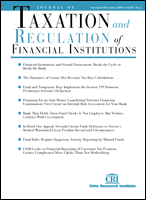Complete Issue
Author: Houman Shadab.
Source: Volume 28, Number 06, July/August 2015 , pp.1-52(52)

< previous article |return to table of contents
Abstract:
In our first article, Miriam L. Fisher and Brian C. McManus identify several mistakes commonly made and issues often-overlooked when financial institutions file a foreign bank account report (FBAR) under the Bank Secrecy Act. As the authors note, due to multilateral reporting obligations, it is easy for a filer to make mistakes—and given rigorous enforcement it is likely such mistakes will be discovered—but, fortunately, it also is quite to possible to correct FBAR errors. In the aftermath of bank failures sparked by the 2008 financial crisis, the Federal Deposit Insurance Corporation (FDIC) has been pursuing former bank directors and officers with new vigor. In our second article, Ryan T. Scarborough and Richard A. Olderman focus on the FDIC’s unwillingness to grant defendants pre-litigation access to documents, how this hampers defendants’ ability to mount a defense, and how officers and directors can best overcome the disadvantage. Captive insurance companies are established mostly by non- financial corporations to help insure their own risks. But, as Beckett G. Cantley and F. Hale Steward explain in our third article, captives can be quite useful to financial institutions. The authors detail the unique risks faced by financial services firms for which captive insurance companies are particularly valuable, including cyber risks, legal liability, and regulatory change. In our fourth article, Joseph J. Patry discusses the current split among circuit courts about whether meaning of “applicant” under the Equal Credit Opportunity Act includes a spouse that is required to provide a personal guaranty. The Supreme Court will be deciding the issue in its next term, and Mr. Patry explains the differing circuit and lower court views and analyzes the implications for lenders should the Supreme Court define “application” to include guarantors. Whether a financial instrument is treated as debt or equity for tax purposes is important in a wide variety of contexts. Galia Antebi and Nina Krauthamer, in our fifth article, discuss the contrasting outcomes in two cases, one involving PepsiCo and the other Hewlett-Packard (HP). HP failed to persuade the Tax Court it warranted equity treatment, largely because the court looked beyond the instrument to the role of shareholders. The authors analyze the arguments made by HP in its pending appeal, comparing and contrasting them to the PepsiCo case’s facts. We conclude the issue with a U.S./International column: Peter Zaman and Claude Brown discuss the impact of negative interest rates on derivatives agreements, especially the funding mismatch problem. The authors focus on commodity collateral documentation used in agreements common in European markets and how they apply in such situations.Keywords: Foreign Account Tax Compliance Act, D&O, FDIC, captive insurance, cyber risk, Equal Credit Opportunity Act, debt- equity analysis, negative interest rates
Affiliations:
1: New York Law School.